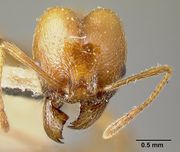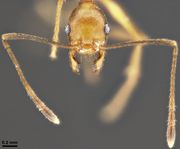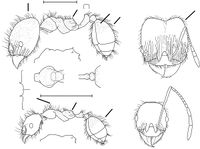Key to Pheidole biconstricta group
This worker key is based on: Wilson, E. O. 2003. Pheidole in the New World: A dominant, hyperdiverse ant genus. Harvard University Press, Cambridge, MA.
These large, abundant, and aggressive ants form a relatively compact group with closest relationships to species of either the diligens or fallax groups. The species range variously from Mexico through Central America and tropical South America; they are unknown from the West Indies north of Trinidad. Pheidole biconstricta itself is highly variable and may contain two or more sibling species. Pheidole plato belongs to this group in all characters except for its possession of 4 hypostomal teeth instead of the 2 characteristic of the group.
You may also be interested in
1
- Propodeum of major and minor completely lacking spines, the basal and declivitous surfaces of propodeum seen in profile joined by a smooth curve (Mexico to Nicaragua) . . . . . Pheidole biconstricta (Pheidole inermis form)
 Pheidole inermis, Major |
- Propodeum of major and minor bearing paired spines, which in one species (socrates) are reduced to denticles . . . . . 2
2
return to couplet #1
- Major: first gastral tergite smooth and shiny; in side view, the pilosity of dorsum of head that extends above the profile is appressed, and the hairs are oriented almost parallel to head surface (Costa Rica) (placed in diligens group; keyed out here also to ensure identification) . . . . . Pheidole biolleyi
 Pheidole biolleyi, Major |
- Major: median half of first gastral tergite foveolate and opaque; hairs extending above the dorsal profile of head erect to suberect . . . . . 3
3
return to couplet #2
- Dorsal surface ofpronotum mostly covered by parallel transverse carinulae; occiput covered by completely appressed, longitudinally oriented hairs; profile of vertex seen in side view flat (Brazilian Amazon) . . . . . Pheidole fissiceps
 Pheidole fissiceps, Minor |
- Dorsal surface of pronotum lacking carinulae; occiput lacking appressed hairs as described above; profile of vertex seen in side view convex . . . . . 4
4
return to couplet #3
- Major possesses 4 hypostomal teeth; major and minor pronotum in side view with a subangular convexity just in advance of the mesonotal hump, especially prominent in the minor (Ecuador) . . . . . Pheidole plato
- Major possesses 2 hypostomal teeth (occasionally 4 in biconstricta andfissiceps); major and minor with no extra pronotal convexity, or if present it is evenly rounded . . . . . 5
5
return to couplet #4
- Large species (Head Width of major 1.8 mm, of minor 0.9 mm); propodeal spine of major only a denticle, shorter than width of the propodeal spiracle; major and minor light reddish yellow (Brazilian Amazon, Guianas) . . . . . Pheidole socrates
 Pheidole socrates, Major |
- Small species (Head Width of major 1.4-1.6 mm, of minor 0.6-0.8 mm); propodeal spine as long as width ofpropodeal spiracle or longer; major and minor reddish yellow or light brown . . . . . 6
6
return to couplet #5
- Head densely pilose, in full-face view with a fringe of dozens of suberect hairs; head and mesosomal dorsa of minor seen from side with dense covering of hairs, many longer than length of the eye; body reddish yellow (Amazonian Brazil and Peru) . . . . . Pheidole simplex
Pheidole simplex, Major |
- Head sparsely pilose, in full-face view exclusive of clypeus with only a scattering of at most several hairs; head and mesosomal dorsa of minor seen from side with sparse hairs, most not as long as length of eye; body light brown (widespread in South and Central America) . . . . . Pheidole biconstricta
Pheidole biconstricta, Major |











